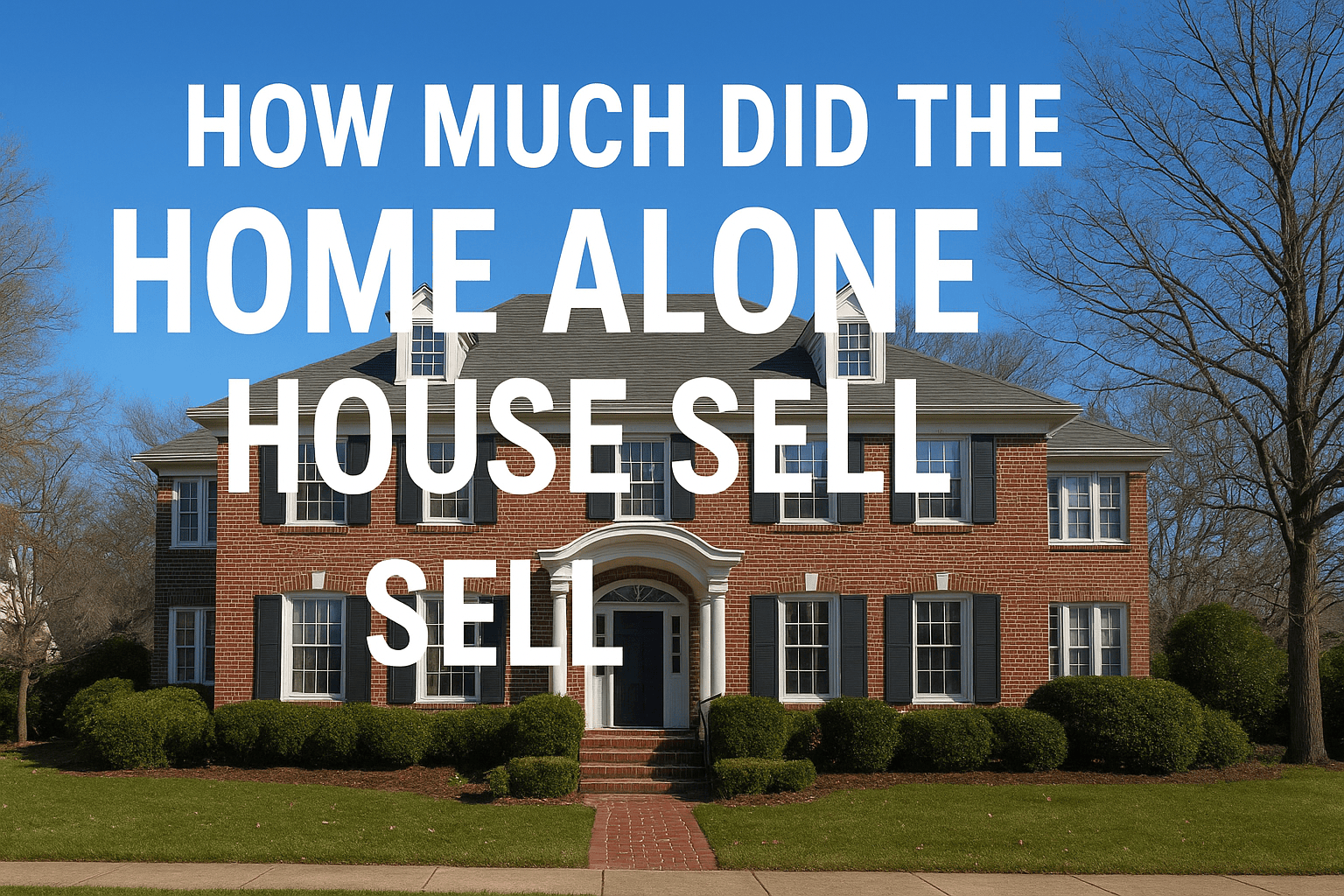
Some movie houses age into quiet nostalgia. Others become part of holiday tradition. The Home Alone house belongs to the second group. Every December, it shows up on screens across the world, twinkling under Christmas lights while Kevin McCallister defends it with paint cans and marbles.
But beneath that cinematic magic lies a real question: how much did the Home Alone house sell for? The answer mixes Hollywood fame with good old real estate math.
The Real House, Not a Movie Set
Unlike many film homes, this wasn’t a studio creation. The house is a genuine suburban property in Winnetka, Illinois, about 20 miles north of Chicago. Built in 1921, it’s a classic Georgian-style home with red brick, white trim, and symmetrical windows — the kind of architecture that feels timeless.
When Home Alone was filmed in 1990, director Chris Columbus and writer John Hughes wanted something that screamed “warm, upper-middle-class family life.” This house fit perfectly. It wasn’t too grand, but it looked comfortable, safe, and just a little nostalgic — the perfect backdrop for chaos.
Movie Magic in Real Life
Only the exterior and entryway scenes were shot on-site. Most of the interiors — including the famous staircase and kitchen — were recreated on a high school gym stage nearby. Still, the real home became an icon. Every brick, every wreath, every flicker of light felt familiar to anyone who ever wished for a McCallister-style Christmas.
After filming, the house went back to being private property. For years, fans quietly drove by, snapped photos, and moved on. It was a living landmark — famous, but still functional.
How Much Did the Home Alone House Sell For?
The big moment came in May 2022, when the Home Alone house sold for about $1.585 million. That price wasn’t inflated for fame — it aligned with other high-value homes in Winnetka. The property offers five bedrooms, five bathrooms, and about 5,400 square feet of space.
For comparison, similar homes in the neighborhood often list between $1.3 and $1.8 million. The final figure put it comfortably in that range — respectable, not absurd.
Still, it’s hard to separate the number from nostalgia. You’re not just buying a house; you’re buying a piece of American holiday culture. That’s worth more than granite countertops.
The Market Around It
Winnetka sits in one of Chicago’s wealthiest suburbs — tree-lined, peaceful, and packed with historic homes. Real estate there rarely dips, even when markets fluctuate.
So while Home Alone fame gave the property attention, the true driver was location. Large lot, top schools, and architectural integrity — all the things serious buyers value.
In other words, the house would have sold well even without Kevin’s traps. Fame just added curiosity.
Ownership History
After the movie, the original owners continued to live there quietly. They tolerated visitors and even gave small interviews about life inside a film landmark. Later owners maintained the property’s integrity — no wild remodels, no theme-park gimmicks.
The 2022 buyers, a private family, reportedly loved the home for its layout and warmth. They weren’t buying a movie set. They were buying comfort.
Even so, they knew the responsibility that came with it. You can’t live there without a few camera-toting tourists slowing down on your street.
Inside the House
The interiors look modern but familiar. Hardwood floors, elegant crown molding, and soft lighting make the space inviting. The staircase remains — less dramatic without ornaments flying through the air, but still recognizable.
Over the years, updates added modern fixtures and new finishes. The kitchen gleams with stainless steel. The bathrooms are sleek and bright. Yet, the house still feels like the one from the movie — warm and family-friendly.
That’s the balance: modernization without erasing nostalgia.
A Real Estate Icon
When people think of famous movie houses, this one ranks near the top. It’s not haunted, not tragic, not extreme. It’s aspirational. It looks like the kind of home people dream of owning someday — stable, safe, and a little storybook.
That relatability helped the Home Alone house become a national symbol. For millions, it represents childhood, laughter, and the best kind of chaos.
So yes, the $1.585 million sale carried emotional weight far beyond the square footage.
Airbnb for a Night
In 2021, before the sale, Airbnb briefly turned the Home Alone house into a themed rental for fans. Guests could stay for one night, complete with traps, pizza, and movie props.
The stunt went viral. It proved that nostalgia sells — not just in theaters but in experiences. For one night, fans didn’t just watch the movie; they lived it.
That marketing moment probably boosted public interest before the sale. Smart timing. Smart business.
Value Beyond the Price
Real estate experts often debate whether fame inflates property value. Usually, it depends on the kind of fame. A notorious story can drag prices down. A beloved movie can lift them up.
In this case, Home Alone added charm, not risk. Buyers weren’t afraid of crowds. They were intrigued by legacy.
Even if the next owners never mention it, the address will always hold quiet fame. Realtors know that kind of awareness is gold — not for price, but for recognition.
Architecture and Craft
Strip away the movie, and you still have an impressive example of 1920s craftsmanship. The red brickwork, black shutters, and stately front door are textbook Georgian Revival. It’s a design built to age gracefully, not chase trends.
Inside, wide hallways and tall ceilings give it breathing space. It’s a layout meant for big families and long dinners.
That solid foundation explains why the house photographs so well. The camera didn’t make it charming; it just captured what was already there.
The Cultural Weight of Nostalgia
Why does this house matter so much? Because it’s woven into collective memory. Every December, millions of families rewatch Home Alone and unconsciously reconnect with that front porch, that snowy driveway, that glow from the windows.
The house isn’t just a backdrop — it’s a character. When people saw it hit the market, curiosity wasn’t about price; it was about emotion.
It reminds us how architecture and film can merge to define eras. Some sets fade away. This one became seasonal tradition.
Media Frenzy
When the listing went live, media outlets from CNN to People covered it instantly. Social feeds lit up with photos and disbelief that it was a real home.
Reporters called it “the most famous Christmas house in America.” Articles compared the sale price to other pop culture properties, from the Breaking Bad home to Tony Stark’s fictional mansion.
The tone was mostly lighthearted — people love a good “movie house sold” story. It’s safe nostalgia in an unpredictable world.
Real-World Maintenance
Fame doesn’t exempt you from gutters and property taxes. The Home Alone house still needs yearly upkeep. Older homes demand attention — roofs, foundations, and heating systems.
That’s the unglamorous side of owning history. You can’t just rely on movie charm. Maintenance is what preserves value.
In that sense, the new owners bought both a home and a responsibility. They hold a piece of pop culture that also happens to need HVAC servicing like everyone else.
Comparisons to Other Movie Homes
Pop culture real estate forms its own strange niche. The Poltergeist house sold for $1.28 million. The Breaking Bad home has become a fenced-off landmark. The Home Alone house sits comfortably between them — famous but livable.
Its fame doesn’t come from fear or drama. It comes from family and humor. That’s a rare blend.
Most people wouldn’t want to live in the Amityville Horror house. But almost anyone would love to live in Kevin McCallister’s. That matters for value and appeal.
Real Estate Lessons
The sale teaches a few truths about fame and property:
- Location still wins. A strong neighborhood supports long-term value.
- Emotion sells. Buyers remember how a house made them feel.
- Condition counts. Even icons need updates to stay relevant.
- Fame fades. But good architecture lasts.
In short, nostalgia can open the door, but practicality closes the deal.
What the House Represents
Beyond numbers, the Home Alone house represents comfort, safety, and independence — the very themes that made the movie timeless. It’s the American family dream with holiday sparkle.
Owning it means inheriting a story. Living there means protecting it while still making it your own. That’s a balance most famous homes never achieve.
The Timeless Appeal of Familiar Spaces
The house’s magic lies in familiarity. It looks like somewhere you might visit for dinner, not a film set. That ordinary charm is what made it cinematic gold.
Even 30 years later, the sight of those red bricks and snow-covered eaves still triggers something warm. It’s proof that movie moments can outlive their actors.
Closing Thoughts
So, how much did the Home Alone house sell for? About $1.585 million — a fair market price wrapped in decades of sentiment.
The number tells part of the story. The rest lives in memory.
The house endures because it stands for something simple — family, chaos, laughter, and resilience. You could say it’s America’s unofficial Christmas card.
And while markets shift and trends fade, one thing’s certain: that red-brick home in Winnetka will always belong to more than one family. Every December, millions of viewers step inside again, if only through a screen.
A house can be sold, but some addresses never really change hands.

